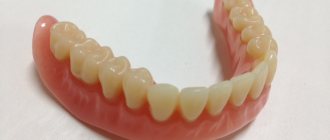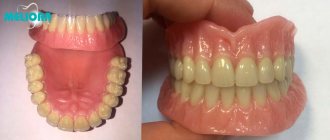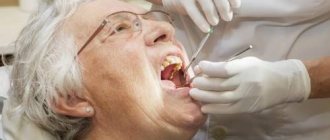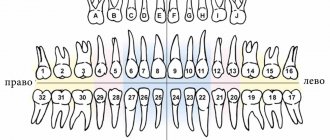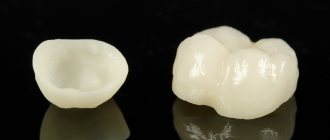How a partial denture is attached to the jaw
There are 3 options for fastening removable structures: hooks (clasps), locks (attachments), telescopic crowns.
We propose to consider each of the options in more detail. Clasps. They are hooks made of metal or plastic that grip healthy teeth and fix the orthopedic structure in the mouth. The disadvantage of such fastening is poor fixation and unsatisfactory aesthetics. Despite the fact that the hooks are covered by the lip, they are visible to others when smiling and talking.
Attachments. More preferable from an aesthetic point of view. The special lock consists of 2 parts. One element is built into the base of the prosthesis, and the other is attached to the crown that covers your own tooth. This fastening option has a more reliable fixation and gives the product stability. In addition, the attachments distribute the chewing load more evenly, which slows down bone atrophy by almost 2 times.
Telescopic crowns. Presented by a system consisting of 2 crowns. The inner one follows the contours of the ground tooth. The outer one is connected to the base and restores the shape of the tooth. This allows the prosthesis to be securely fixed and prevents it from moving. The possibility of installing a telescopic structure in each specific case is determined by the doctor, since grinding of a large layer of hard tissue of the supporting tooth is required.
Which complete denture is best?
Today there are quite a lot of such designs on the market, so the question of which complete removable dentures are better is quite reasonable. In the case of this type of orthopedic system, the main factor that determines its quality was and remains the material of manufacture. Designs on mini-implants stand apart because they are conceptually different from other designs. We will discuss below what materials are most often used for complete removable dentures.
| Types of complete removable dentures | Description |
| Complete removable denture on implants | These are the best complete removable dentures that are installed after implantation. Fixation is also possible with mini-implants. They are installed not into bone (like classic ones), but into soft tissue. Mini-implantation allows you to achieve optimal load distribution and the most reliable fixation among all types of removable dentures. |
| Complete removable acrylic denture | The most affordable, but at the same time the least high-quality complete dentures, which are made from acrylic plastics. |
| Complete removable nylon denture | A more elastic and comfortable prosthesis that is superior to plastic structures in aesthetics and comfort, but distributes the chewing load worse (does not apply to all models). |
| Complete removable denture Akri Free | The best removable denture for complete absence of teeth in its class. The Akri Free prosthesis is hypoallergenic and comfortable to wear, but has sufficient rigidity for high-quality restoration of chewing function. |
Complete removable denture supported by implants.
Indications and contraindications for use
Partial removable dentures are used in cases where the jaw is missing only a few teeth, but there are own healthy teeth that will be used as supporting teeth. Suitable for restoring both chewing and front teeth. The use of removable partial dentures is recommended in the following cases:
- missing several teeth;
- end defects of the jaw;
- atrophied bone tissue;
- the need for temporary prosthetics;
- contraindications to the installation of implants.
There are practically no contraindications to this type of prosthetics, and they are all temporary. These include viral diseases, carious lesions of teeth and periodontal tissue diseases.
Stages of manufacturing a removable partial denture
Depending on the type of prosthesis, the course of orthopedic treatment may differ slightly, but, in general, prosthetics can be divided into several main stages:
Preparation. After examination and diagnosis, the orthopedic doctor draws up a treatment plan and helps with choosing the optimal design option suitable for your particular case. At this stage, the oral cavity is sanitized. If necessary, teeth that cannot be saved are removed.
Taking impressions. Using impression material and a custom tray, the specialist takes impressions of the teeth on both jaws.
Manufacturing of the structure. In the dental laboratory, wax models are cast from the impressions, from which the technician makes the dentures.
Fitting and fixation. At the last visit, the doctor tries on the structure and fixes it in the oral cavity. If necessary, the prosthesis is adjusted and polished according to the bite.
Mistakes in the manufacture of complete removable dentures
Shortening the boundaries of the prosthesis.
Because of this error, the prosthesis does not stick to the jaw (in a clever way - the integrity of the circular marginal valve is violated) and does not stay on it.
What to do? The doctor cuts off the edge of the prosthesis even further. Warms wax or thermoplastic material. And applies it to the prepared edge, lengthening it. He again heats the wax glued to the edge and puts the prosthesis on the jaw. Functional tests form a new edge of the prosthesis.
Next, the technician changes the wax or thermoplastic to plastic.
There is another method to adjust the edge of the prosthesis without a technician. Using self-hardening plastic. This method is worse due to the properties of the plastic itself. It has more pores and residual monomer. It also shrinks when it hardens. And it gets very hot, burning the patient’s mouth.
If the prosthesis is shortened along line A.
In this place, the edge of the prosthesis should fit perfectly to the mucous membrane. That's why the doctor tries harder.
At first he does everything as in the previous case. Shortens the edge. Makes a roller from wax (thermoplastic). Shoots the back edge. But then he also adds a layer of corrective impression material on top of the wax. And so he takes the impression. The soft palate must be relaxed.
Balancing.
The doctor may skip it at the testing stage because the wax base is very plastic. H is more likely to be deformed, and the balancing will be imperceptible. But it will appear on a hard plastic base.
What to do? If the balancing is very strong, the prosthesis is remade.
If the doctor decides that everything is not so bad, he can do a relocation.
Relining a removable denture:
The doctor uses a milling cutter to cut off a layer of plastic from the inside of the prosthesis. Cola thickness is 1 mm. He applies a corrective mass of impression material to this place. Prosthesis as an individual spoon. And he takes an impression. The patient closes his mouth in central occlusion. The prosthesis is removed from the jaw and given to the technician. Which will replace the print with plastic.
Lifespan of removable partial dentures
Practice shows that the service life of removable plate structures is on average 3-5 years, after which the structure has to be changed. Bugel products have a longer lifespan - up to 5-7 years.
In general, the duration of wearing depends on several factors:
— the quality of the design and the professionalism of the specialist who carried out the installation;
— characteristics of the body and the condition of the oral cavity, the presence of gum diseases and deformation of the dentition;
— accuracy of compliance with doctor’s recommendations and proper home care.
ACRI-FRI - prostheses that do not break
ACRI-FRI is the latest material for removable denture bases, high strength.
Denture bases are made by injection molding from acrylic resin. Does not contain polymethyl methacrylate or methyl methacrylate.
- Increased strength characteristics (do not break)
- Possibility of use for any dental defects
- Excellent reproduction of the relief of the oral cavity
- High hygiene due to extremely low water absorption and non-survival of microorganisms
- Long service life
- Fits exactly, does not deform
- Does not cause allergies
Prostheses made from the latest VERTEX (see picture) have long been loved by our patients, whose comfort cannot be compared with any acrylic plate prosthesis.
VERTEX is the latest hot polymerization plastic, high strength with the addition of silicone for the manufacture of partial, complete removable dentures, as well as for complete dentures supported by implants.
To increase comfort and quick adaptation, a soft silicone gasket with a long shelf life made of VERTEX SOFT material is used. Its advantages:
- Does not absorb odors
- Doesn't peel off
- Polymerizes together with the prosthesis base
Rules for wearing and caring for prostheses
The first time after installation, removable dentures can cause discomfort. As a rule, it goes away by the end of the first week. In some cases, especially when using plate structures, addiction can last up to 3 weeks.
To speed up adaptation, there are general rules and recommendations: rinse your mouth with warm water more often, do not overload the denture with solid food for the first 3-4 days.
Carefully monitor hygiene, rinse your mouth after every meal, and beware of excessive chewing loads. For cleaning, you should not use abrasive cleaners; give preference to special solutions and pastes.
Are partial dentures repairable?
During use, individual parts of the prosthesis may break off. Under no circumstances should you attempt to repair it yourself; it is better to contact a specialist. If the situation can be corrected, it will only take a couple of days to fix it.
Every six months to a year, during a scheduled visit to the dentist, it is necessary to reline the plate and clasp structures, since the contour of the gums and the level of bone tissue change over time. The adjustment improves fit and load distribution, resulting in the product not chafing or breaking.
The most frequently asked questions about partial dentures
Is an allergy possible? How long does it take to get used to? Do you need fixing gels when wearing? You can find out the answers to these and other most popular questions in this section of the article.
— Is it possible to have an allergic reaction?
Is it possible. As a rule, an allergy can occur to acrylic when wearing plate dentures. Or on metal if wearing a clasp design. Before installing a prosthesis, a doctor may recommend that particularly sensitive people undergo a special test for sensitivity to materials.
— How long does it take to get used to it?
Sometimes it can take up to 3-4 weeks to get used to it. This usually applies to plate dentures, since they are more noticeable in the oral cavity. Clasp designs do not require so much time.
— Do I need to use fixing gels when wearing partial structures?
Partial structures do not require additional fixation, since they already have fastenings (hooks or clasps).
— Do I need to take off my dentures at night?
It is not at all necessary to remove the structure at night. It is not even recommended to remove the prosthesis for the first 3-4 weeks after installation, since there is an adaptation period. Further, at the discretion of the patient.
— Are there any restrictions when wearing?
Avoid eating excessively hard foods such as nuts or ice. It is also not recommended to eat foods that are too viscous and stick to artificial teeth.
Rules for using removable dentures
When everything has been checked and all errors have been corrected, the doctor tells the patient how to use the prosthesis:
“You need to get used to the prosthesis,” says the doctor. – Everyone gets used to it differently. Usually around 5-7 days. I advise you to wear the prosthesis around the clock for the first five days, and only take it off for cleaning.
At first you may feel nauseous. Drooling will increase. The prosthesis will be very annoying. This is normal and should go away in 1 day.
I advise you to somehow distract yourself. Work, an exciting movie or a good book. Everything will do.
It will be difficult to speak at first - talk more and it will pass
For the first 5 – 7 days, eat soft, it is better to grind food. Then gradually switch to normal
After eating, the dentures should be washed and the mouth rinsed. The denture should be cleaned twice a day. Buy a special brush; regular toothpaste will do. Clean your dentures in the morning after breakfast and in the evening after dinner. Place the denture in the box at night. But first, soak it in an antiseptic solution for an hour. There are special elixirs and tablets. But, for example, a chlorhexidine solution is also suitable.
In the morning, brush your gums and tongue with a soft toothbrush. This will improve blood circulation in the gums and freshen your breath.
Well, that’s it, I’m making an appointment for you tomorrow, I need to make sure that the prosthesis doesn’t interfere.
If it rubs too much, remove it. But be sure to put it on 3 hours before coming to see me. I have to see exactly where the prosthesis is in the way.”
The doctor says goodbye to the patient, but his work with this prosthesis does not end there. No matter how hard the doctor and technician try, the prosthesis often rubs and needs to be adjusted.
Partial dentures - reviews from specialists and patient opinions
In general, reviews of removable dentures from patients and doctors are positive. If there are contraindications to the installation of fixed structures, removable prosthetics are the only treatment option.
However, experts are confident that if there are no restrictions on implantation, the choice should be opted for prosthetics on implants. This option is the most preferable in terms of longevity, aesthetics, safety and prevention of bone atrophy.
What is the cost of a partial denture?
First of all, the price varies depending on the type of prosthesis and the number of lost teeth. Many are sure that a high-quality prosthesis cannot be very cheap. So what does its cost consist of?
The material of construction plays a big role in pricing. Modern dental clinics work with proven compounds for the manufacture of structures. This guarantees the quality, aesthetics and durability of the product.
All designs are made individually, based on the characteristics of the jaw structure, patient preferences and doctor’s recommendations.
Professionalism of staff and technical equipment. The experience of an orthopedist and dental technician, as well as high-tech equipment, is very important, so the price tag also adds up in terms of costs.
Where in Voronezh can a partial removable denture be installed?
For a quality result, it is important to choose a dental clinic and attending physician wisely. Making the wrong choice can create a lot of problems and cost you a lot of time and money to fix the mistake. Be sure to pay attention to the specialist’s experience, the availability of modern equipment and reviews of other patients.
You can install partial removable dentures in Voronezh at. We offer production using modern equipment, high-quality materials and competitive prices. Our consummate specialists are always ready to help. We are waiting for you for your first free consultation!
Limits of the prosthesis for the upper and lower jaw
Recently, there has been a desire to free natural teeth from the prosthetic base adjacent to them. This is not always possible when producing plate dentures with conventional retaining clasps that do not have improved devices for fixation. However, this should be done where possible, particularly in maxillary dentures. So, for example, if there is a continuous row of frontal teeth on the upper jaw, but there are no premolars and first molars, and the palatine ridge is not pronounced, it is necessary to free the anterior segment of the palate. So, based on all that has been said, we will trace the boundaries of the partial removable denture for the upper and lower jaws, starting from the center line on the vestibular side. Limits of the upper jaw prosthesis. On the upper jaw, in the presence of an artificial gum, it is necessary to release the labial frenulum, then the boundaries of the prosthesis pass near the transitional lining to the buccal cords, where again it is necessary to make a notch; then the boundaries follow along the transitional fold to the alveolar cusps, which (in the absence of the last molars) are completely covered by a plate, remembering what was said regarding the rounded bony protrusions. In addition, the alveolar tubercles serve as an additional means for fixing the prosthesis. As for the distal edge of the prosthesis, its borders are not brought to line “a”, i.e., to the soft palate, so that the prosthesis does not cause unpleasant sensations, but an arched notch is made. The boundaries vary here depending on the location of the natural teeth and the shape of the palatal vault (Fig. 68). If the defect in the dentition is limited to the posterior teeth, the distal edge of the prosthesis covers the tooth adjacent to the defect or its half. It is better to bypass the palatal ridge without covering it with a plate. The torus prevents the uniform immersion of the prosthesis into the underlying tissue and causes instability, and often its fracture.
If the dimensions and location of the palatine ridge (torus) are such that it is impossible to bypass it, then a corresponding notch is made in the base plate. Near natural teeth, the boundaries of the prosthesis pass according to the rules described above.
Borders of the prosthesis for the lower jaw. On the vestibular side of the lower jaw, as well as on the upper jaw, it is necessary to release the labial frenulum and buccal cords and make sure that the edges of the prosthesis do not pass onto the mobile mucous membrane of the cheeks. The alveolar cusps on the mandible are mucosal elevations and are therefore never covered with a partial denture plate. Otherwise, they may push away the prosthesis or be pinched by it. When determining the boundaries of the lower edge of the prosthesis on the lingual side, the lingual frenulum is released so as not to impede the movements of the tongue, and the boundaries are continued along the internal oblique line. Particular attention should be paid to the round projections in the premolar area. These protrusions must be covered with a plate, otherwise there will be complaints of pain when using the prosthesis, which is not always possible to eliminate. The distal edges of the prosthesis are finished depending on the relief of the internal oblique line. If there are sharp bony protrusions, the edges of the prosthesis do not extend beyond their level. The upper border of the prosthesis on the lingual side passes, as already indicated, above the most convex part as the frontal ones. and lateral teeth.


